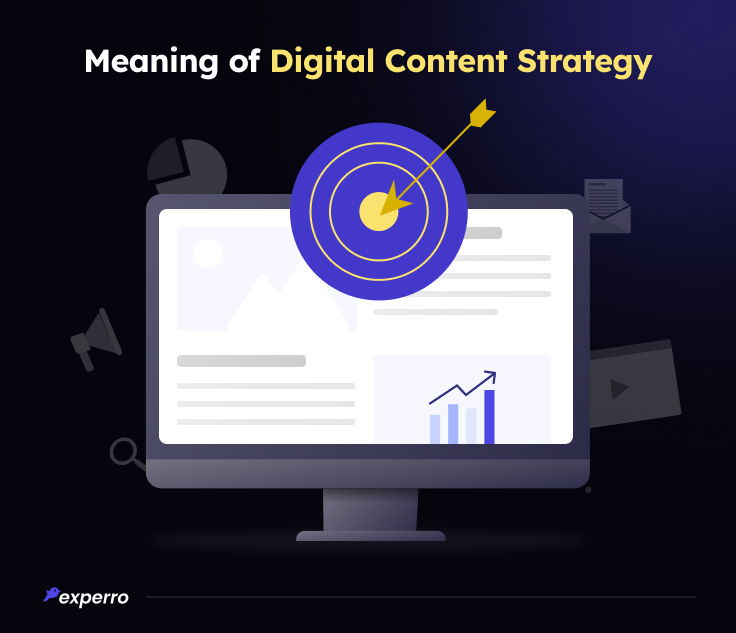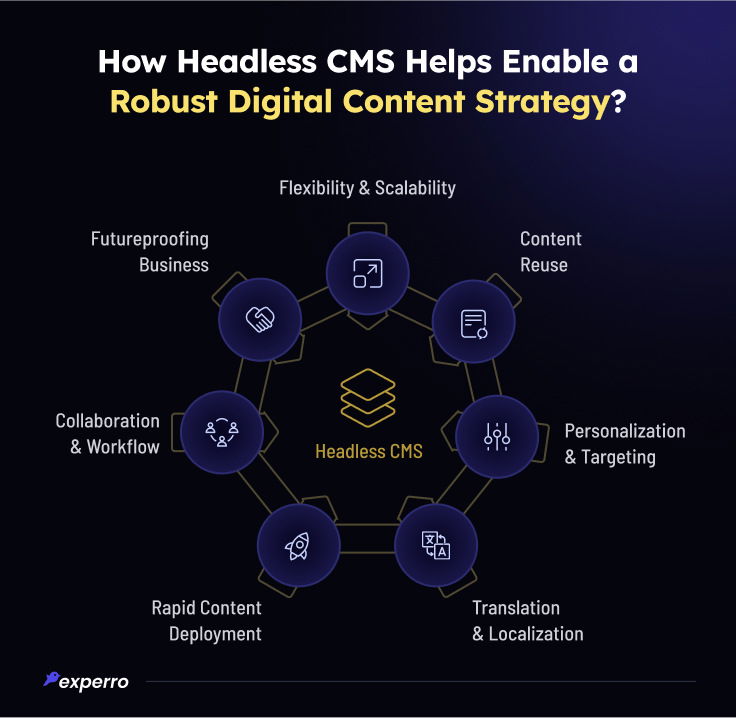A Step-By-Step Guide On Digital Content Strategy

What’s Inside
- What Is a Digital Content Strategy?
- Why is Digital Content Strategy Important for Your Success?
- Steps to Create a Digital Content Strategy for Your Business
- How a Headless CMS Can Help with Digital Content Strategy?
- Want to Accelerate Online Business?
- Common Mistakes to Avoid While Creating Digital Content Strategy
- Best Tools to Create Digital Content Strategy
- How Experro Can Help with Building and Maintaining Your Digital Content Strategy?
- Conclusion
Key Takeaways
- A well-defined digital content strategy boosts your business's online presence, making it easier for customers to find you.
- Digital content strategy provides a roadmap for consistent growth in achieving specific business objectives over time.
- A headless CMS like Experro enables seamless content distribution across multiple channels and boosts digital strategy.
A robust digital content strategy is more than a necessity - it's the cornerstone of online success.
This strategy, an integral part of digital content marketing, lays the foundation for businesses to connect with their target audience, elevate their brand, and navigate the competitive digital landscape.
As we delve into the intricacies of digital content planning and creation, we'll uncover the pivotal role of strategic thinking in crafting content that resonates, engages, and converts.
A well-orchestrated digital content plan, informed by search engine optimization and enriched with high-quality content, sets the stage for a narrative that informs, inspires, and compels action.
What Is a Digital Content Strategy?

A digital content strategy encompasses planning, developing, managing, and optimizing content to achieve specific business and marketing goals.
It's the blueprint guiding digital content creation that resonates with target audiences, ensuring that every piece of content, from blog posts to social media updates, is purposeful and aligned with overarching business goals.
This strategy involves keyword research, understanding search engine optimization (SEO), and effectively leveraging digital channels to distribute content.
By adhering to a digital content strategy best practice guide, businesses can ensure their content efforts contribute to brand awareness, customer engagement, and business growth.
Why is Digital Content Strategy Important for Your Success?
A well-crafted digital content strategy is pivotal for business success in the digital landscape. It transcends mere digital content creation, embodying a holistic approach that includes digital content planning and execution aligned with business goals.
This strategic framework ensures your content marketing efforts are targeted, cohesive, and effective, enhancing search engine optimization and audience engagement.
By adopting digital content strategies rooted in best practices, businesses can significantly increase brand awareness, foster lead generation, and nurture a loyal target audience.
It's not just about creating content; it's about creating the right content for the right people and time.
Aligns with Business Goals
A well-defined digital content strategy ensures that every piece of content, whether a blog post, social media update, or video content, directly contributes to your overarching business objectives.
This alignment helps streamline efforts toward achieving specific goals such as increasing sales, enhancing customer engagement, or building brand authority.
Enhances SEO and Visibility
Effective digital content strategies incorporate keyword research and SEO best practices to improve your content's visibility on search engines.
It increases organic traffic and positions your brand as a credible source of information in your industry.
Engages Target Audience
Understanding your target audience's needs, preferences, and behavior allows you to create content that speaks directly to them.
This personalized approach boosts engagement, fosters loyalty, and enhances the user experience, making your content more impactful and memorable.
Guides Content Creation
A strategic framework provides clarity and direction for content creation, helping you produce high-quality content that is relevant and valuable to your audience.
The strategic approach ensures that resources are utilized efficiently, and content is created purposefully and precisely.
Measures Success
By defining clear key performance indicators (KPIs) as part of your content strategy, you can measure the effectiveness of your content efforts.
Regularly reviewing these metrics allows you to refine and adapt your strategy, ensuring continuous improvement and alignment with your business goals.
For more in-depth insights, exploring resources like the Digital content from Wikipedia.
Steps to Create a Digital Content Strategy for Your Business
By following the steps mentioned below, businesses can implement a comprehensive digital content strategy that drives revenue.
- Conduct a Content Audit: Review and evaluate all existing content for performance and relevance.
- Set Clear Goals: Align content objectives with business goals using SMART criteria.
- Understand Your Audience: Research to create detailed buyer personas.
- Choose Appropriate Content Types: Select diverse content formats suitable for different stages of the buyer's journey.
- Plan Content Distribution: Strategically share content across chosen platforms using a content calendar.
- Establish KPIs: Measure content strategy success with relevant metrics like traffic and engagement rates.
- Refine Strategy Continuously: Adapt your approach based on analytics, market trends, and audience feedback.
- Leverage a Headless CMS: Enhance content delivery and personalization across multiple channels and devices.
- Avoid Common Pitfalls: Ensure clear objectives, consistent publishing, SEO integration, and audience engagement.
Creating a digital content strategy involves a series of deliberate steps and considerations to ensure the content reaches the intended audience and engages and converts them effectively.
Here's a more detailed guide on crafting your business's comprehensive digital content strategy.
Conducting a Content Audit
Conducting a thorough content audit is the first step towards a robust digital content strategy.
This process involves reviewing all existing content to evaluate its performance and relevance to your target audience.
A content audit helps identify high-performing pieces that can be updated or repurposed and underperforming content that needs optimization or removal.
The audit should cover various content types across all digital channels, including websites, blogs, social media platforms, and email campaigns.
Key metrics include page views, engagement, conversion, and SEO performance.
Defining Your Goals
Clear, measurable goals are the cornerstone of a successful digital content strategy.
These goals should be closely aligned with your overall business objectives: increasing brand awareness, generating leads, boosting sales, or improving customer loyalty.
Setting SMART (Specific, Measurable, Achievable, Relevant, Time-bound) goals will guide your content strategy and help measure its effectiveness over time.
Identifying Your Target Audience
Understanding who your content is for is critical to creating content that resonates and converts.
This step involves conducting audience research to gather insights into your target audience's demographics, preferences, pain points, and content consumption habits.
Developing detailed buyer personas based on this research will enable you to tailor your content more effectively to meet the needs and interests of your audience segments.
Deciding on Content Types
The above quote emphasizes the fact that content is the biggest driving force for people to come to search engines.
The choice of content types should be influenced by your audience's preferences and the goals of your content strategy.
A diverse content mix can include blog posts, videos, infographics, podcasts, eBooks, and more.
It's essential to consider the various stages of the buyer's journey and select appropriate content formats for each stage, from awareness to consideration to decision.
Planning Content Distribution
Content distribution is as important as content creation. Your content distribution plan should detail where and how your content will be shared to reach your target audience effectively.
This includes choosing the right platforms, whether it's your website, social media, email newsletters, or third-party platforms.
A content calendar is valuable for organizing and scheduling your content publishing to ensure a consistent and timely presence across all channels.
TIP - Omnichannel content distribution using a headless CMS allows businesses to provide seamless customer experience irrespective of the digital channels.
Establishing Key Performance Indicators (KPIs)
KPIs for customer experience are essential for measuring the success of your content strategy.
These should align with your content goals and include metrics such as website traffic, engagement rates, lead generation, conversion rates, and social shares.
Regularly tracking these KPIs will provide valuable insights into what's working and what isn't, allowing for data-driven adjustments to your strategy.
Refining Your Strategy
A digital content strategy should be dynamic, adapting to changes in audience behavior, market trends, and the performance of your content.
Use analytics and feedback to continually refine your strategy, experimenting with new content ideas, formats, and distribution channels to enhance engagement and achieve better results.
How a Headless CMS Can Help with Digital Content Strategy?

To execute the digital content strategy, businesses will need a definitive system. Let's explore how headless CMS can help with the digital content plan through the following aspects:
1. Flexibility & Scalability
Today's dynamic digital landscape is continuously evolving with breakthroughs and solutions.
As a matter of fact, users consume content not only from websites but various digital channels such as social media, mobile apps, IoT devices, and more.
In this case, the content should be able to adapt to different screen sizes and channels for a seamless user experience.
Headless CMS has a flexible and scalable architecture that makes this possible. This means irrespective of the user's choice of a platform or channels; the content can be delivered seamlessly.
2. Content Reuse
Headless CMS enables content reuse with the modular content approach. It allows marketers to create different content modules that can be used later on different digital channels.
This means there is no requirement for creating content from scratch when publishing on various platforms.
Marketers can simply rearrange the content blocks and create a personalized experience with the modular content approach of headless CMS.
3. Personalization & Targeting
There is no one-size-fits-all content that caters to every user.
Recent data about personalization says that 60% of consumers will become repeat customers after a personalized shopping experience.
Because every user is unique, and their needs and preferences are different, not every user can relate to the same content.
Hence, personalized content delivery is the key to getting users' attention and compelling them to make a purchase decision.
TIP - eCommerce merchandising assists with personalization by tailoring product recommendations to individual user preferences and behavior.
4. Translation & Localization
Translation and localization are important for a digital content strategy because they enable businesses to reach global audiences and connect with diverse markets effectively.
- Translation is the process of converting content from one language to another.
- Localization involves creating content as per the cultural, linguistic, and regional preferences of specific target markets.
A headless CMS can help with translation and localization by providing a centralized platform for managing content in multiple languages and regions.
A headless CMS can help with translation and localization by providing a centralized and gen AI-powered customer data platform for managing data in multiple languages and regions.
It allows content creators to easily update and adapt content for different markets while maintaining a consistent brand message.
5. Rapid Content Deployment
It is all about keeping up with the trends and delivering the quickest content to the customer.
Been researching Black Friday strategies? Create personalized content instantly on your landing page to attract customers.
With a headless CMS facilitating content delivery through a CDN, it ensures lightning-fast content distribution. Plus, scalability guarantees uninterrupted page performance, eliminating concerns about downtime.
6. Collaboration & Workflow
Did you know 75% of employees believe collaboration and teamwork are essential?
Collaboration ensures that content creators, editors, and reviewers can work together efficiently, streamlining content production processes.
It allows for thorough content reviews, quality assurance, and the incorporation of diverse perspectives, ultimately enhancing content quality and relevance.
A headless CMS further simplifies and enhances collaboration by centralizing content, offering smooth content workflows, controlling user access through role-based permissions.
7. Futureproofing Business
A headless CMS can easily integrate with your favorite 3rd party tools to enhance user experience and improve employee productivity.
Common Mistakes to Avoid While Creating Digital Content Strategy
Crafting a digital content strategy requires careful planning and execution. However, even with the best intentions, it's easy to fall into common traps that can undermine the effectiveness of your content efforts.
To ensure the success of your digital content plan, it's crucial to be aware of and avoid these pitfalls:
Lack of Clear Objectives
One of the foundational elements of a successful digital content strategy is setting clear, achievable objectives. A common mistake is creating content without a well-defined purpose or goals.
This lack of direction makes it difficult to align your content with your business objectives and complicates the measurement of success and return on investment (ROI).
To avoid this, start by defining what you want to achieve with your content: enhancing brand awareness, driving traffic, generating leads, or boosting conversions.
Ensure these goals are specific, measurable, achievable, relevant, and time-bound (SMART) to guide your content creation and evaluation process effectively.
Ignoring Audience Needs
Understanding and addressing your target audience's needs, challenges, and interests is crucial for engaging content.
A significant mistake is creating content based solely on what you think your audience might like without conducting thorough audience research.
This assumption can lead to content that needs to be revised, failing to resonate with or engage your audience.
To prevent this, invest time developing detailed buyer personas and conducting audience research to gain insights into their content preferences, consumption habits, and pain points.
Tailoring your content to meet these specific needs ensures higher engagement and relevance.
Inconsistent Publishing
Consistency is key in building and maintaining a solid online presence.
An erratic publishing schedule can harm your brand's credibility and weaken audience engagement.
Consistent content creation and distribution can make your audience understand and lead to losing interest or trust in your brand.
To maintain a consistent and reliable presence, develop a content calendar that outlines what content will be published and when.
This helps organize your content strategy and ensures regular engagement with your audience, keeping your brand in mind.
Neglecting SEO
Search Engine Optimization (SEO) plays a vital role in ensuring your content is discoverable by your target audience.
Neglecting SEO is a common oversight that can significantly diminish your content's visibility and organic reach.
Incorporating SEO best practices, such as keyword research, on-page optimization, and quality backlinking, into your content strategy enhances your content's chances of ranking higher in search engine results pages (SERPs).
This increased visibility drives more traffic to your content and, by extension, to your website or platform.
To avoid overlooking SEO, ensure that SEO is an integral part of your content planning process, from keyword research to content creation and optimization.
TIP – SEO-friendly headless CMS like Experro provides flexibility to structure and optimize content for search engines.
By steering clear of these common mistakes and adopting a strategic, audience-focused approach to your digital content strategy, you can create content that reaches, resonates with, and engages your target audience, driving tangible results for your business.
Best Tools to Create Digital Content Strategy
Utilizing the right set of tools is indispensable to craft and execute a powerful digital content strategy.
These tools streamline the content creation and management process and provide invaluable insights into your strategy's performance, enabling continuous optimization.
Here's a more detailed look at the essential tools for developing a comprehensive digital content plan, including content management systems, SEO tools, analytics platforms, and content planning tools.
Content Management Systems (CMS)
Content management systems are foundational to any digital content strategy, offering a user-friendly platform for creating, managing, and publishing content.
While WordPress and Drupal have long been popular for their flexibility and extensive plugin ecosystems, it's essential to consider newer, more specialized platforms like Experro, BigCommerce, and Shopify.
- WordPress: Known for its versatility, WordPress powers a significant portion of the internet.
Its vast array of themes and plugins makes it suitable for everything from simple blogs to complex websites. - Drupal: Drupal is favored for its robust security features and flexibility, making it ideal for complex, content-rich websites that require custom functionality.
- Experro: Tailored for businesses looking to enhance their digital content strategy, Experro offers a unique blend of content lifecycle management capabilities and digital marketing tools.
It's designed to streamline content workflows and enhance content operations, making it easier for teams to produce high-quality content that resonates with their target audience. - BigCommerce and Shopify: While primarily known as eCommerce platforms, BigCommerce and Shopify also offer robust CMS functionalities.
They are particularly suited for businesses that aim to integrate their content marketing efforts with their online store, providing seamless management of both content and products.
SEO Tools
Effective search engine optimization ensures your content reaches its intended audience.
Tools like SEMrush and Ahrefs are indispensable for conducting keyword research, competitor analysis, and SEO audits, ensuring your content is optimized for search engines and your target audience.
- SEMrush: Offers comprehensive SEO toolkits, including keyword research, site audits, and competitor analysis features.
It's invaluable for understanding your search engine ranking position and identifying opportunities for improvement. - Ahrefs: Known for its powerful backlink analysis capabilities, Ahrefs is also excellent for keyword research, content exploration, and ranking tracking.
It helps craft an SEO strategy that drives organic traffic and improves content visibility.
Analytics Platforms
Understanding how your content performs is key to refining and improving your strategy. Google Analytics is critical for tracking content performance, user engagement, and conversion rates.
It provides detailed insights into user behavior, traffic sources, and content effectiveness, enabling data-driven decision-making.
- Google Analytics: This free tool offers a wealth of data about your website's performance, from page views and bounce rates to conversion tracking. Integrating Google Analytics into your digital content strategy allows for continuous monitoring and optimization based on real-time data.
Content Planning Tools
Organizing your content creation and publishing schedule is vital for maintaining a consistent and strategic presence.
Tools like Trello, Asana, and CoSchedule offer powerful content planning and collaboration solutions, ensuring your content strategy is well-organized and aligned with your business objectives.
- Trello: With its intuitive board and card system, Trello facilitates easy organization of content ideas, schedules, and workflows.
It's beneficial for visualizing your content calendar and collaborating with team members. - Asana: Asana provides more comprehensive project management features, making it suitable for managing complex content projects and workflows.
Its timeline view and integration capabilities ensure seamless coordination across different teams. - CoSchedule: Specifically designed for content planning, CoSchedule integrates with your CMS and social media platforms, allowing you to plan, schedule, and publish content from a single dashboard.
It's an excellent tool for managing your content strategy and editorial calendar.
By leveraging these tools, you can create a digital content strategy that effectively reaches and engages your target audience and continuously evolves based on data-driven insights and optimization.
How Experro Can Help with Building and Maintaining Your Digital Content Strategy?
Experro specializes in supporting businesses to craft and maintain an effective digital content strategy:
- Customized Content Plans: Develop a tailored digital content plan that aligns with your business objectives and audience needs.
- Content Creation and Management: Offer services ranging from content creation to management using advanced tools and platforms.
- Analytics and Optimization: Provide analytics services to track the performance of your content and suggest optimizations for better results.
- Expert Consultation: Access to experienced content strategists and marketers to guide your digital content efforts.
By following these steps and considering the support tools and services available, businesses can develop a strong digital content strategy that drives engagement, leads, and sales.
Conclusion
In crafting a robust digital content strategy, businesses unlock the potential to reach and deeply engage with their target audience, turning digital channels into powerful conduits of connection and conversion.
This journey from the initial content audit to the meticulous planning and execution of a digital content plan embodies the essence of effective digital content marketing strategy.
Utilizing a suite of sophisticated tools, from content management systems like Experro to SEO enhancers like SEMrush, and organizing platforms such as Trello, ensures that your content not only meets but exceeds the evolving expectations of your audience.
Each piece of content, whether a blog post, video content, or social media update, serves as a building block in a larger content marketing strategy to drive meaningful engagement and achieve business goals.
Remember, a successful digital content strategy goes beyond mere content creation; it's about crafting high-quality content that resonates, informs, and inspires.
With a strong foundation in digital content planning and a commitment to continuous optimization, your brand can effectively navigate the digital marketing landscape, fostering a genuine connection with your audience and setting the stage for enduring success.
FAQs


Priya Zala
13 June 2024Through her writing, she has a lovely way of capturing users' pain points and delivering solution-oriented content. Her writing is sure to captivate readers and leave them with a lasting impression. When not crafting content, Priya enjoys getting lost in a good work of fiction, which soothes her soul.